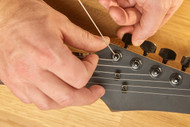Fresh Sounds: How to Change Strings on Your Electric Guitar with Ease
Apr 9th 2024

Fresh Sounds: How to Change Strings on Your Electric Guitar with Ease
Is your electric guitar no longer sounding like a majestic instrument? There’s a good chance the strings are the culprit. Even the most durable guitar strings eventually wear out and need to be replaced. Putting a new set on can feel like getting a new axe!
In this guide, our musicians go over how to change electric guitar strings and enjoy a fresh new sound. We also look at adjustments you may need to make after changing the strings. Remember you can find hundreds of guitar strings at Strings and Beyond from all the leading brands.
How Often to Change Electric Guitar Strings
You might be able to go up to three months between changing electric guitar strings — or you might need to change them after every show. Here are some signs you need to change guitar strings.
- The strings sound dull or thin.
- They fall out of tune easily.
- Your strings feel rough or have corrosion from sweat and humidity.
- A string has broken.
- You want to try a different string gauge, material or brand.
How to Restring an Electric Guitar
So what do you do when your guitar needs new strings? Let’s go over the process step by step.

Removing Old Guitar Strings
- 1.Lay the guitar on a flat surface with a large book, pillow or guitar headstand under the neck to keep it from moving around. Put a towel underneath the guitar’s body to prevent scratches.
- 2.Turn the tuning peg for the low E-string to unwind it until it no longer has enough tension to make a note. A winding tool such as the D’Addario DP0002 Guitar Pro Winder can make this go faster. (If you’re not sure whether you’re turning the peg in the correct direction, pluck the string as you turn.)
- 3.Remove the string from the tuning post and bridge hole. Some people cut the old string(s) in half using wire cutters. While this makes it easier to remove the strings, it also creates additional sharp edges that can puncture skin, and it will make it harder to recycle the strings.
NOTE: If you are just changing the strings without any other maintenance, put each new string on before removing the next old string. This will keep the neck tension as normal as possible and let the strings stabilize faster. You can remove all the strings at once to clean the fretboard, polish the guitar, etc., but install the new strings as soon as you’re done, as too much time without tension can cause neck warping.

Adding New Guitar Strings
- 4.Confirm you’re installing the correct string (low-E, A, etc.). This is usually on the packaging label; some electric guitar strings also have color-coded ball ends.
- 5.Unwind the string, insert the non-ball end through the bridge hole and pull the string through so the ball end catches. Make sure to not let the string grind or rub on the bridge hole.
- 6.Align the string in the proper slots along the saddle and headstock nut.
- 7.Pull the string through the corresponding tuning peg while leaving 1-2 inches (about the first fret or two) of slack. This will leave enough slack to tighten the string around the post without binding.
- 8.Slowly turn the tuning knob to tighten the string. On electric guitars where all six posts are in a row, you’ll be turning counterclockwise. For guitars with three posts on each side, turn counterclockwise on the bass strings (low-E, A, D) and clockwise on the treble strings (G, B, high-E). Reverse this on a left-handed guitar.
- 9.Tune the string using a guitar tuner. Some people set the strings a little sharp, then let the guitar sit overnight to help the strings stretch and settle faster. Just don’t tune them too sharply as the added tension increases the chances of broken strings.
- 10.Use the wire cutters to clip the excess string hanging out of the tuning post.
- 11.After changing each string, retune the guitar, since the neck tension will continue to change as you work. Depending on the strings, they can take up to a week to fully settle.

Setting up an Electric Guitar After You Change Strings
If you’re replacing your old strings with the same style — a set of D’Addario EXL110s with another set of D’Addario EXL110s, for example — you shouldn’t need to do any further setup. However, changing to a different brand or gauge may require adjusting the relief, action and intonation once the strings have settled.
The relief is the amount of neck curvature. Switching to a lighter string gauge will reduce tension and decrease the curve (i.e. less relief); the opposite happens with a heavier string gauge. Both affect how the guitar will play. Adjust the relief by turning the truss rod nut at the top of the neck with an Allen wrench. Turn clockwise for less relief and counterclockwise for more relief. Go a quarter-turn at a time to avoid over-adjusting.
The action is how close the strings are to the frets, which is typically measured at the 12th fret. Too much space makes the guitar harder to play while not enough space causes “fret buzz.” About 2.4mm of action on the bass strings and 1.6mm on the treble strings is a good starting point. Raise or lower the bridge height to adjust the action.
The intonation is whether the string remains in tune as you move up the neck. To check this, tune the string as normal, then play it on the 12th fret (the octave). If this note is flat or sharp, adjust the saddle using a small screwdriver. Moving the saddle away from the neck will flatten the intonation while moving it closer to the neck will sharpen the intonation.

